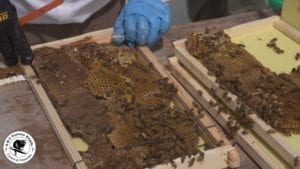Throughout the spring and summer months, ABC Humane Wildlife fields many client inquiries about honey bee removal and the best techniques for getting rid of bees. I am always very proud to educate them about the extraordinary benefits honey bees offer our ecosystem and discuss ABC’s dedication to honey bee sustenance and growth. To us, honey bee control never means getting rid of bees.
The Benefits of Bees
Honey bees are responsible for pollinating many of the plants we depend upon for food, which means if they weren’t around, it’s entirely possible we’d be facing a food crisis. Also, their honey has been used as a natural remedy all over the world for everything from easing allergies to serving as an antibacterial and antimicrobial agent. They are truly remarkable creatures, and ABC Wildlife does everything in our power to help develop and expand their populations.
When Honey Bee Control Becomes Necessary
Unfortunately, sometimes the places honey bees feel are perfect to build their hives aren’t so perfect for us. Honey bees are cavity nesters, so they seek
ABC Wildlife Are Experts in Honey Bee Removal

If you need honey bee control, our team of honey bee removal and relocation experts will be very excited to help you. Call us today at (847) 870-7175 to learn how getting rid of bees can still be humane and beneficial to the environment!
Technician Ben:
When it comes to honey bee removal, we kind of have to have x-ray eyes to basically be able to tell where they’re building their comb in the voided spaces of a structure. We’ll determine which direction the bees are going to once they enter the hole, and then that’s where we’ll start with our exploratory plunge cuts. We’re making small openings in the materials to see exactly where the comb is. Once we’ve determined where the comb is, we’ll mark out the area of materials to be removed so that the comb is fully exposed, and there’s ease of access for the actual extraction. The free-form comb that’s in these voided spaces; the bees had their own design for it. We’re trying to mesh their own free-form comb into our hive bodies and our hive frames. The comb has got the food, the honey, the nectar, the pollen, and the brood, the larvae of the young worker bees. We need to get all of that out.
Once we get the comb extracted out of the wall, we’ll roughly shape it to fit inside of this frame, and then we’ll put the frames into the hive body, and then cap it off, transfer them, and relocate them. The reason we want to take the free-formed comb and get it into frames is so that we can properly help manage the bees. By us removing all of the honey with the bees and the comb, there’s no longer a food source for other types of pests like ants, mice, other flying stinging things that are looking to forage on that free honey. By extracting them from the outside, we’re able to keep the bees alive and keep that diversity of their genetics in the gene pool.
The majority of our customers feel very strongly about doing honey bee control this way as opposed to just killing them off, because they are aware of the fact that there is colony collapse and there are all of these pressures on the honey bees with people getting rid of bees.
Most generally, there was some type of gap or hole or deficiency that led these bees to find these voided spaces, so as a form of preventative means, we’ll help the customer out by sealing those areas directly located where we do the honey bee removal.
We brought the bees to one of ABC’s apiaries. This is the Harvard location. It’s a good location. There’s lots of places for them to forage, lots of wildflower, older growth forest, and it’s pretty diverse as far as the types of trees. This extraction has been extremely successful from start to finish. The client’s extremely happy, and we’re happy to be able to give these guys a home that’s out of the flight path of people, so we’re eliminating that risk to human health and safety. It’s not necessarily an exact science, but we’re getting really good at developing special techniques to ensure that we have the most successful honey bee removal, and every extraction, depending on the size, is more and more successful.
I love the fact that were capable of basically removing thousands of things that equate to one super organism and then relocate them to another place and ensure their continued health and happiness. I definitely love that aspect of honey bee removal.
Sharing is caring! If you’ve learned something from what you’ve read, please click one of the icons below to share this post on social media.
Karen Jesse is a wildlife writer and educator licensed by the Illinois Department of Natural Resources and the Illinois Department of Public Health in urban wildlife management and structural pest control. She enjoys hiking, telling people how cool skunks are, and opera.


